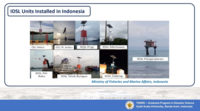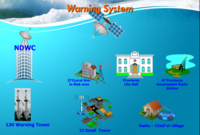15 June 2022 (online)
In recognition of the recent challenges in tsunami disaster risk reduction, ADRC adopted the theme "Understanding Tsunami Risk and Enhancing Practical Countermeasures" for the tsunami seminar that was held on 15 June 2022. One of the challenges is how to further reduce tsunami disaster risk. Although tsunamis occur only rarely, their impacts are deadlier (e.g., over 230,000 people were killed in the Indian Ocean Tsunami of 2004) and costlier (e.g., the economic impact of the Great East Japan Earthquake and Tsunami of 2011 was about USD235 billion ? the highest in world history) than other hazards. Another challenge is how to improve knowledge of tsunami risks, especially with regard to non-earthquake sources of tsunamis (e.g., the Sunda Strait Tsunami of 2018 and the Tonga Volcanic Eruption and Tsunami of 2022) so that early warning systems and other preparedness measures can be likewise improved. Furthermore, there is the ongoing challenge of how to augment physical countermeasures (e.g., levees) with practical countermeasures (e.g., awareness-raising, actionable early warnings, and simple evacuation procedures) at the community level.
For this seminar, ADRC invited three experts to share their experiences and insights:
1) Dr Teuku Alvisyahrin, Professor at Syiah Kuala University and Former Head of the Professional Services Division of the Tsunami and Disaster Mitigation Research Center, Banda Aceh, Indonesia;
2) Mr Somneuk Swatteuk, Disaster Early Warning Specialist at the National Disaster Warning Center of the Department of Disaster Prevention and Mitigation, Ministry of Interior in Thailand; and
3) Mr ARAKIDA Masaru, Director of the Research Department, ADRC
Below are among the messages that came up during the discussions.
1) Tsunami risks are dynamic. As shown in the experiences of Thailand
and Indonesia, tsunami risks can increase or decrease depending on the community's ability to reduce vulnerabilities. At the time of the Indian Ocean Tsunami of 2004, the risk was high since tsunami knowledge, understanding, and countermeasures were limited. In Thailand, the establishment of the National Disaster Warning Center (NDWC) has been one of the efforts in reducing tsunami risk through the use of early warning system (EWS) technologies. Similar efforts have been reported in Indonesia, with the installation of cheap but effective tsunami early warning systems (TEWS) such as Inexpensive Devices for Sea Level Monitoring (IDSL), which are designed to reduce tsunami risk.
2) Practical countermeasures may be scaled up to enhance community
resilience. With tsunami early warning systems (TEWS) in place, the authorities can now issue tsunami early warnings and determine the lead time needed for evacuation. However, since practical countermeasures at the community level differ in Indonesia, Thailand, and Japan, it is important to exchange experiences (e.g., how to evacuate the pregnant, disabled, and elderly during a tsunami) so that communities can further learn and improve their respective countermeasures.
3) Space-based technology augments response efforts during a tsunami
disaster. As highlighted particularly in the experience of Japan, images taken by space satellites during the Great East Japan Earthquake were valuable in assessing tsunami disaster impacts by comparing before and after photos. During the Tonga Volcanic Eruption and Tsunami of January 2022, satellite images were useful in creating pre- and post-disaster vegetation maps. These augmented the disaster response and recovery efforts from the tsunami event, where ground-based technologies were disrupted.
Overall, the discussions implied that in order to reduce the impacts of tsunami disasters in the future, it is essential to learn more about tsunami risks and continue sharing information and experiences. Most importantly, the knowledge and skills of tsunami countermeasures must be passed on to the next generation so that they are not forgotten.
(2022/07/31 15:00)



